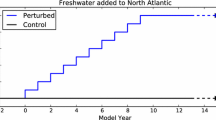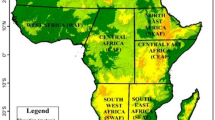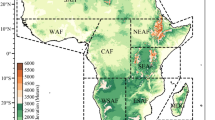Abstract
This study presents near future (2020–2044) temperature and precipitation changes over the Antarctic Peninsula under the high-emission scenario (RCP8.5). We make use of historical and projected simulations from 19 global climate models (GCMs) participating in Coupled Model Intercomparison Project phase 5 (CMIP5). We compare and contrast GCMs projections with two groups of regional climate model simulations (RCMs): (1) high resolution (15-km) simulations performed with Polar-WRF model forced with bias-corrected NCAR-CESM1 (NC-CORR) over the Antarctic Peninsula, (2) medium resolution (50-km) simulations of KNMI-RACMO21P forced with EC-EARTH (EC) obtained from the CORDEX-Antarctica. A further comparison of historical simulations (1981–2005) with respect to ERA5 reanalysis is also included for circulation patterns and near-surface temperature climatology. In general, both RCM boundary conditions represent well the main circulation patterns of the historical period. Nonetheless, there are important differences in projections such as a notable deepening and weakening of the Amundsen Sea Low in EC and NC-CORR, respectively. Mean annual near-surface temperatures are projected to increase by about 0.5–1.5 \(^{\circ }\)C across the entire peninsula. Temperature increase is more substantial in autumn and winter (\(\sim \) 2 \(^{\circ }\)C). Following opposite circulation pattern changes, both EC and NC-CORR exhibit different warming rates, indicating a possible continuation of natural decadal variability. Although generally showing similar temperature changes, RCM projections show less warming and a smaller increase in melt days in the Larsen Ice Shelf compared to their respective driving fields. Regarding precipitation, there is a broad agreement among the simulations, indicating an increase in mean annual precipitation (\(\sim \) 5 to 10%). However, RCMs show some notable differences over the Larsen Ice Shelf where total precipitation decreases (for RACMO) and shows a small increase in rain frequency. We conclude that it seems still difficult to get consistent projections from GCMs for the Antarctic Peninsula as depicted in both RCM boundary conditions. In addition, dominant and common changes from the boundary conditions are largely evident in the RCM simulations. We argue that added value of RCM projections is driven by processes shaped by finer local details and different physics schemes that are introduced by RCMs, particularly over the Larsen Ice Shelf.














Similar content being viewed by others
References
Abram N, Mulvaney R, Vimeux F et al (2014) Evolution of the southern annular mode during the past millennium. Nat Clim Change 4:564–569. https://doi.org/10.1038/nclimate2235
Addor N, Rohrer M, Furrer R, Seibert J (2016) Propagation of biases in climate models from the synoptic to the regional scale: implications for bias adjustment. J Geophys Res Atmos 121:2075–2089. https://doi.org/10.1002/2015JD024040
Agosta C, Fettweis X, Datta R (2015) Evaluation of the CMIP5 models in the aim of regional modelling of the Antarctic surface mass balance. Cryosphere 9:2311–2321. https://doi.org/10.5194/tc-9-2311-2015
Bozkurt D, Rondanelli R, Marín J, Garreaud R (2018) Foehn event triggered by an atmospheric river underlies record-setting temperature along continental Antarctica. J Geophys Res Atmos 128(3):3871–3892. https://doi.org/10.1002/2017JD027796
Bozkurt D, Bromwich DH, Carrasco J, Hines KM, Maureira JC, Rondanelli R (2020) Recent near-surface temperature trends in the Antarctic Peninsula from observed, reanalysis and regional climate model data. Adv Atmos Sci 37:477–493. https://doi.org/10.1007/s00376-020-9183-x
Bracegirdle TJ, Connolley WM, Turner J (2008) Antarctic climate change over the twenty first century. J Geophys Res 113(D03):103. https://doi.org/10.1029/2007JD008933
Bromwich DH, Hines KM, Bai LS (2009) Development and testing of polar weather research and forecasting model: 2. Arctic Ocean J Geophys Res 114(D08):122. https://doi.org/10.1029/2008JD010300
Bromwich DH, Nicolas JP, Monaghan AJ, Lazzara MA, Keller LM, Weidner GA, Wilson AB (2013) Central West Antarctica among the most rapidly warming regions on Earth. Nature Geosci 6:139–145. https://doi.org/10.1038/ngeo1671
Bromwich DH, Nicolas JP, Monaghan AJ, Lazzara MA, Keller LM, Weidner GA, Wilson AB (2014) Corrigendum: Central West Antarctica among the most rapidly warming regions on Earth. Nat Geosci 7:76. https://doi.org/10.1038/ngeo2016
Bruyére CL, Monaghan AJ, Steinhoff DF, Yates D (2015) Bias-corrected CMIP5 CESM data in WRF/MPAS intermediate file format. NCAR Tech. Note NCAR/TN-515+STR, NCAR, Boulder
C3S (2017) ERA5: Fifth generation of ECMWF atmospheric reanalyses of the global climate. Copernicus Climate Change Service (C3S) Climate Data Store (CDS)
Cape MR, Vernet M, Skvarca P, Marinsek S, Scambos M, Domack E (2015) Foehn winds link climate-driven warming to ice shelf evolution in Antarctica. J Geophys Res Atmos 120(11):37–11057. https://doi.org/10.1002/2015JD023465
Carrasco JF (2013) Decadal changes in the near-surface air temperature in the western side of the Antarctic Peninsula. Atmos Clim Sci 3:275–281
Clem KR, Lintner BR, Broccoli AJ, Miller JR (2019) Role of the South Pacific convergence zone in West Antarctic decadal climate variability. Geophys Res Lett 46:6900–6909. https://doi.org/10.1029/2019GL082108
Convey P, Smith RIL (2006) Responses of terrestrial Antarctic ecosystems to climate change. Plant Ecol 182(1–2):1–10
Delhasse A, Kittel C, Amory C, Hofer S, van As D, Fausto SR, Fettweis X (2020) Brief communication: evaluation of the near-surface climate in ERA5 over the Greenland Ice Sheet. Cryosphere 14(3):957–965. https://doi.org/10.5194/tc-14-957-2020
Di Luca A, Elia R, Laprise R (2013) Potential for small scale added value of RCMs downscaled climate change signal. Clim Dyn 40(3–4):601–618. https://doi.org/10.1007/s00382-012-1415-z
Ding Q, Steig E, Battisti D, Kuttel M (2011) Winter warming in West Antarctica caused by central tropical Pacific warming. Nat Geosci 4:398–403. https://doi.org/10.1038/ngeo1129
Dong X, Wang Y, Hou S, Ding M, Yin B, Zhang Y (2020) Robustness of the recent global atmospheric reanalyses for Antarctic near-surface wind speed climatology. J Clim 33:4027–4043. https://doi.org/10.1175/JCLI-D-19-0648.1
Elvidge AD, Renfrew IA, King JC, Orr A, Lachlan-Cope TA, Weeks M, Gray SL (2015) Foehn jets over the Larsen C Ice Shelf, Antarctica. Q J R Meteorol Soc 141:698–713. https://doi.org/10.1002/qj.2382
Frieler K, Clark PU, He F, Buizert C, Reese R, Ligtenberg SR, Van den Broeke MR, Winkelmann R, Levermann A (2015) Consistent evidence of increasing Antarctic accumulation with warming. Nat Clim Change 5:348–352
Giorgi F, Jones C, Asrar GR (2009) Addressing climate information needs at the regional level: the CORDEX framework. WMO Bull 58:175–183
Gossart A, Helsen S, Lenaerts JT, Broucke SV, van Lipzig NP, Souverijns N (2019) An evaluation of surface climatology in state-of-the-art reanalyses over the Antarctic Ice Sheet. J Clim 32:6899–6915. https://doi.org/10.1175/JCLI-D-19-0030.1
Graham LP, Hagemann S, Simon J, Beniston M (2007) On interpreting hydrological change from regional climate models. Clim Change 81:97–122
Grassi B, Redaelli G, Visconti G (2006) A physical mechanism of the atmospheric response over Antarctica to decadal trends in tropical SST. Geophys Res Lett 33(L17):814. https://doi.org/10.1029/2006GL026509
Guttler I, Stepanov I, Branković C, Nikulin G, Jones C (2015) Impact of horizontal resolution on precipitation in complex orography simulated by the Regional Climate Model RCA3. Mon Weather Rev 143:3610–3627. https://doi.org/10.1175/MWR-D-14-00302.1
Hazeleger WC, Severijns C, Semmler T et al (2008) EC-Earth—a seamless earth-system prediction approach in action. Bull Am Meteorol Soc 91:1357–1364. https://doi.org/10.1175/2010BAMS2877.1
Hersbach H, Bell B, Berrisford P et al (2020) The ERA5 global reanalysis. Q J R Meteorol Soc. https://doi.org/10.1002/qj.3803
Hines KM, Bromwich DH (2008) Development and testing of Polar WRF. Part I: Greenland ice sheet meteorology. Mon Weather Rev 136:1971–1989
Hines KM, Bromwich DH, Bai LS, Barlage M, Slater AG (2011) Development and testing of Polar WRF. Part III: Arctic Land. J Clim 24:26–48. https://doi.org/10.1175/2010JCLI3460.1
Hoegh-Guldberg O, Jacob D, Taylor M, Bindi M, Brown S, Camilloni I, Diedhiou A, Djalante R, et al (2018) Impacts of 1.5\(^{\circ }\)C global warming on natural and human systems. In:Global warming of 1.5\(^{\circ }\)C. An IPCC Special Report on the impacts of global warming of 1.5\(^{\circ }\)C above pre-industrial levels and related global greenhouse gas emission pathways, in the context of strengthening the global response to the threat of climate change, sustainable development, and efforts to eradicate poverty. Masson-Delmotte, V., P. Zhai, H.-O. Pörtner, D. Roberts, J. Skea, P.R. Shukla, A. Pirani, W. Moufouma-Okia, C. Pén, R. Pidcock, S. Connors, J.B.R. Matthews, Y. Chen, X. Zhou, M.I. Gomis, E. Lonnoy, T. Maycock, M. Tignor, and T. Waterfield (eds.)
Hosking JS, Orr A, Marshall GJ, Turner J, Phillips T (2013) The influence of the Amundsen–Bellingshausen Seas low on the climate of West Antarctica and its representation in coupled climate model simulations. J Clim 26:6633–6648. https://doi.org/10.1175/JCLI-D-12-00813.1
Hosking JS, Orr A, Bracegirdle TJ, Turner J (2016) Future circulation changes off West Antarctica: sensitivity of the Amundsen Sea Low to projected anthropogenic forcing. Geophys Res Lett 43:367–376. https://doi.org/10.1002/2015GL067143
Jones ME, Bromwich DH, Nicolas JP, Carrasco J, Plavcová Zou X, Wang SH (2019) Sixty years of widespread warming in the southern mid- and high-latitudes. J Clim 32:6875–6898. https://doi.org/10.1175/JCLI-D-18-0565.1
Jones PW (1999) First- and second-order conservative remapping schemes for grids in spherical coordinates. Mon Weather Rev 127:2204–2210
King JC, Turner J (2009) Antarctic meteorology and climatology. Cambridge University Press, Cambridge. https://doi.org/10.1017/CBO9780511524967
King JC, Gadian A, Kirchgaessner A et al (2015) Validation of the summertime surface energy budget of Larsen C Ice Shelf (Antarctica) as represented in three high-resolution atmospheric models. J Geophys Res Atmos 120:1335–1347. https://doi.org/10.1002/2014JD022604
Lenaerts JTM, Van den Broeke MR, Van de Berg WJ, Van Meijgaard E, Kuipers Munneke P (2012) A new, high-resolution surface mass balance map of Antarctica (1979–2010) based on regional atmospheric climate modeling. Geophys Res Lett 39(L04):501. https://doi.org/10.1029/2011GL050713
Liang XZ, Kunkel KE, Meehl GA, Jones RG, Wang JXL (2008) Regional climate models downscaling analysis of general circulation models present climate biases propagation into future change projections. Geophys Res Lett 35(L08):709. https://doi.org/10.1029/2007GL032849
Listowski C, Lachlan-Cope T (2017) The microphysics of clouds over the Antarctic Peninsula—Part 2: modelling aspects within Polar-WRF. J Geophys Res Atmos 17:10195–10221
Liu Y, Li F, Hao W, Barriot JP, Wang Y (2019) Evaluation of synoptic snowfall on the Antarctic Ice Sheet based on CloudSat, in-situ observations and atmospheric reanalysis datasets. Remote Sens 11(14):1686. https://doi.org/10.3390/rs11141686
Marshall GJ, Orr A, van Lipzig NPM, King JC (2006) The impact of a changing Southern Hemisphere annular mode on Antarctic Peninsula summer temperatures. J Clim 19(20):5388–5404. https://doi.org/10.1175/JCLI3844.1
Marshall GJ, Thompson DWJ, Van den Broeke MR (2017) The signature of Southern Hemisphere atmospheric circulation patterns in Antarctic precipitation. Geophys Res Lett 44:11580–11589. https://doi.org/10.1002/2017GL075998
Naughten KA, Meissner KJ, Galton-Fenzi BK, England MH, Timmermann R, Hellmer HH (2018) Future projections of Antarctic Ice Shelf melting based on CMIP5 scenarios. J Clim 31:5243–5261. https://doi.org/10.1175/JCLI-D-17-0854.1
Niu X, Wang S, Tang J, Lee DK, Gao X, Wu J, Hong S, Gutowski WJ, McGregor J (2015) Multimodel ensemble projection of precipitation in eastern China under A1B emission scenario. J Geophys Res Atmos 120:9965–9980. https://doi.org/10.1002/2015JD023853
Oliva M, Navarro F, Hrbacek F, Hernandez A, Nyvlt D, Pereira P, Ruiz-Fernandez J, Trigo R (2017) Recent regional climate cooling on the Antarctic Peninsula and associated impacts on the cryosphere. Sci Total Environ 580:210–223. https://doi.org/10.1016/j.scitotenv.2016.12.030
Palerme C, Genthon C, Claud C, Kay JE, Wood NB, L’Ecuyer T (2017) Evaluation of current and projected Antarctic precipitation in CMIP5 models. Clim Dyn 48:225–239. https://doi.org/10.1007/s00382-016-3071-1
Rignot E, Casassa G, Gogineni P, Krabill W, Rivera A, Thomas R (2004) Accelerated ice discharge from the Antarctic Peninsula following the collapse of Larsen B Ice Shelf. Geophys Res Lett 31(L18):401. https://doi.org/10.1029/2004GL020697
Rondanelli R, Hatchett B, Rutllant J, Bozkurt D, Garreuad R (2019) Strongest MJO on record triggers extreme Atacama rainfall and warmth in Antarctica. Geophys Res Lett 46(6):3482–3491. https://doi.org/10.1029/2018GL081475
Scambos TA, Bohlander JA, Human CA, Skvarca P (2004) Glacier acceleration and thinning after ice shelf collapse in the Larsen B embayment. Geophys Res Lett 31(L18):402. https://doi.org/10.1029/2004GL020670
Screen JA, Bracegirdle TJ, Simmonds I (2018) Polar climate change as manifest in atmospheric circulation. Curr Clim Change Rep 4:383–395. https://doi.org/10.1007/s40641-018-0111-4
Skamarock WC, Klemp JB, Dudhia J, Gill DO, Barker DM, Duda M, Huang XY, Wang W, Power JG (2008) A description of the advanced research WRF Version 3. NCAR Tech. Note NCAR/TN-475 + STR, NCAR, Boulder
Sørland SL, Schär C, Lüthi D, Kjellström E (2018) Bias patterns and climate change signals in GCM-RCM model chains. Environ Res Lett 13(074):017. https://doi.org/10.1088/1748-9326/aacc77
Taylor KE, Stouffer RJ, Meehl GA (2012) An overview of CMIP5 and the experiment design. Bull Am Meteorol Soc 93:485–498
Tetzner D, Thomas L, Allen C (2019) A validation of ERA5 reanalysis data in the southern Antarctic Peninsula-Ellsworth Land region, and its implications for ice core studies. Geosciences 9:289. https://doi.org/10.3390/geosciences9070289
Turner J, Bracegirdle TJ, Phillips T, Marshall GJ, Hosking JS (2013) An initial assessment of Antarctic sea ice extent in the CMIP5 models. J Clim 26:1473–1484. https://doi.org/10.1175/JCLI-D-12-00068.1
Turner J, Lu H, White I, King JC, Phillips JS, Hosking JS et al (2016) Absence of 21st century warming on Antarctic Peninsula consistent with natural variability. Nature 535:411–415. https://doi.org/10.1038/nature18645
Turner J, Guarino MV, Arnatt J, Jena B, Marshall GJ, Phillips T, Bajish CC, Clem K, Wang Z, Andersson T, Murphy EJ, Cavangh R (2020a) Recent decrease of summer sea ice in the Weddell Sea, Antarctica. Geophys Res Lett. https://doi.org/10.1029/2020GL087127
Turner J, Marshall GJ, Colwell S, Phillips T, Lu H (2020b) Antarctic temperature variability and change from station data. Int J Climatol 40:2986–3007. https://doi.org/10.1002/joc.6378
Van Den Broeke MR, Van Lipzig NPM (2004) Changes in Antarctic temperature, wind and precipitation in response to the Antarctic Oscillation. Ann Glaciol 39:119–126. https://doi.org/10.3189/172756404781814654
Van Lipzig NPM, Marshall GJ, Orr A, King JC (2008) The relationship between the Southern Hemisphere annular mode and Antarctic Peninsula summer temperatures: analysis of a high-resolution model climatology. J Clim 21(8):1649–1668. https://doi.org/10.1175/2007JCLI1695.1
Van Meijgaard E, van Ulft LH, van de Berg WJ, Bosvelt FC, van den Hurk BJJM, Lenderink G, Siebesma AP (2008) The KNMI regional atmospheric model RACMO version 2.1. Tech. Note Tech. Rep. 302, R. Neth. Meteorol. Inst., Netherlands
Van Wessem JM, Ligtenberg SRM, Reijmer CH, Van de Berg WJ, Van den Broeke MR, Barrand NE, Thomas ER, Turner J, Wuite J, Scambos TA, Van Meijgaard E (2016) The modelled surface mass balance of the Antarctic peninsula at 5.5 km horizontal resolution. Cryosphere 10:271–285. https://doi.org/10.5194/tc-10-271-2016
Wilby RL, Whitehead PG, Wade AJ, Butterfield D, Davis RJ, Watts G (2004) Integrated modelling of climate change impacts on water resources and quality in a lowland catchment: River Kennet, UK. J Hydrol 330:204–220
Wille JD, Favier V, Dufour A, Gorodetskaya IV, Turner J, Agosta C, Codron F (2019) West Antarctic surface melt triggered by atmospheric rivers. Nat Geosci 12:911–916
Wilson AB, Bromwich DH, Hines KM (2016) Simulating the mutual forcing of anomalous high-southern latitude atmospheric circulation by El Niño flavours and the Southern Annular Mode. J Clim 29(6):2291–2309. https://doi.org/10.1175/JCLI-D-15-0361.1
Zheng F, Li J, Clark RT, Nnamchi HC (2013) Simulation and projection of the Southern Hemisphere Annular Mode in CMIP5 models. J Clim 26:9860–9879. https://doi.org/10.1175/JCLI-D-13-00204.1
Acknowledgements
This work was funded by ANID-FONDAP-15110009. Deniz Bozkurt acknowledges support from ANID-CONICYT-PAI-77190080, ANID-PIA-Anillo INACH ACT192057 and ANID-FONDECYT-11200101. Contribution number 1597 of Byrd Polar and Climate Research Center. David Bromwich was supported by NSF Grant 1823135. Jorge Carrasco acknowledges support from ANID-FONDECYT-1191932. Polar-WRF simulations were performed within a project entitled “Simulaciones climáticas regionales para el continente Antártico y territorio insular Chileno” funded by Chilean Ministry of Environment. This research was partially supported by the Basal Grant AFB 170001 and the supercomputing infrastructure of the NLHPC (ECM-02:Powered@NLHPC). We acknowledge the World Climate Research Programme,Working Group on Regional Climate, and the Working Group on Coupled Modelling, former coordinating body of CORDEX and responsible panel for CMIP5. We thank the NCAR for providing CESM data in WRF intermediate data format. We also thank the KNMI for producing and making available RACMO model output. The authors appreciate the support of Amazon Web Services (AWS) for the grants PS\(\_\)R\(\_\)FY2019\(\_\)Q1\(\_\)CR2 and PS\(\_\)R\(\_\)FY2019\(\_\)Q2\(\_\)CR2 allowing us to execute the Polar-WRF simulations on the AWS cloud infrastructure. We appreciate the support from Juan Carlos Maureira at Center for Mathematical Modeling, University of Chile for execution of model simulations. We are thankful to Francisca Muñoz, Nancy Valdebenito and Mirko Del Hoyo at CR2 for post-processing of Polar-WRF simulations.
Author information
Authors and Affiliations
Corresponding author
Additional information
Publisher's Note
Springer Nature remains neutral with regard to jurisdictional claims in published maps and institutional affiliations.
Supplementary Information
Below is the link to the electronic supplementary material.
Rights and permissions
About this article
Cite this article
Bozkurt, D., Bromwich, D.H., Carrasco, J. et al. Temperature and precipitation projections for the Antarctic Peninsula over the next two decades: contrasting global and regional climate model simulations. Clim Dyn 56, 3853–3874 (2021). https://doi.org/10.1007/s00382-021-05667-2
Received:
Accepted:
Published:
Issue Date:
DOI: https://doi.org/10.1007/s00382-021-05667-2




